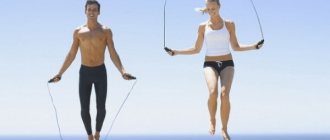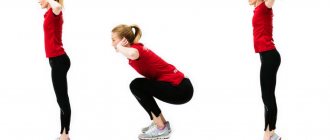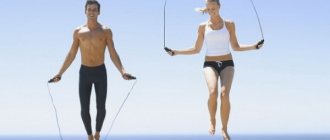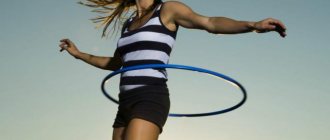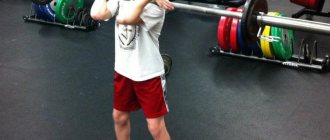What is jumping?
Translated from English, the word “jumping” means “jumping.” Gymnastics on a trampoline appeared by chance, and practice has shown that the loads a person receives during exercise are several times higher. Using a home or indoor trampoline, you can effectively lose weight and improve your mood.
Jumping allows you to train your body, tightening its shape and keeping your muscles toned. Jumping on a mini trampoline, which is specially designed for individual exercise in a small space, allows you to combine stretching and cardio exercise. The training consists of pushing off with your feet from a stretched surface and performing various exercises while in flight and at the same time maintaining your balance.
What you need for a jump - details about equipment
The main thing in any extreme jumping is equipment and equipment. They allow you to enjoy emotions and beautiful views, guaranteeing maximum safety. The main principle of equipment selection is compliance with the necessary criteria. They are different for each element.
Rope
An elastic rubber band is the main component of bungee jumping equipment. Its technical characteristics:
- Resource. The number shows how many jumps the rope is designed for. It is strictly prohibited to exceed this number; the endurance of the cable has been tested with special equipment, so it is an optimal indicator. On the contrary, replacement must be carried out long before this resource is depleted.
- Margin of safety. It is enough to throw cars from a height, not to mention a person. They choose the maximum value to ensure the safety of the process; they also limit the weight of extreme sports enthusiasts to 150-200 kg in order to minimize risks.
- Stretching. The maximum length of the rubber band when jumping. Represents a percentage relative to the length of the rope at rest. The indicator is necessary to accurately calculate the start of the braking system at a certain distance to the ground. The ropes can stretch 2-4 times; this characteristic is important for calculating the length of the rope relative to the weight of the jumper.
For maximum safety, not one rope is used, but many. They are intertwined to prevent accidental breaking of one or more ropes.
Bandages
Special fastenings for legs. They are a set of two soft pads covering part of the leg from the ankle to the middle of the shin, united by a system of flat belts. Depending on the type of jump and equipment, the limbs can be securely fixed together or at a certain distance.
Many athletes additionally use towels or soft non-slip fabric to prevent bruising on their legs after an upward jerk. Specialized professional equipment is made taking into account the loads, so no additional softening is required. When choosing, it is important to take into account the quality of tailoring and the reliability of connections of all belts and locks. Equipment is checked before each jump.
Belt
Another belt system that fits around the torso. Increasing the contact points gives additional confidence in the safety of the jump. Despite the fact that the main elastic band is attached to the bandages on the legs, and the entire jerk falls on the lower part of the body, the fasteners on the middle and upper body help lift the athlete up. Unlike rope jumping, the position of the body changes at the end point, and the jumper is pulled onto the platform with his head up.
Cloth
There are no strict rules. The main thing is that the person is as comfortable as possible, nothing restricts movement. Care must be taken to ensure that things are not too tight or cut into the skin. It is completely necessary to exclude sharp parts, locks, brooches, buttons at the places where belts are attached. The ideal option would be a tracksuit without pockets or zippers.
Platform
The jumping area equipment is a small bridge protruding forward over a gorge or cliff. It is installed in natural conditions. The main criterion is sustainability. When jumping from a bridge where there is a railing or other flat surface from which you can push off, a platform is not placed. A cable is attached to the platform or equipment nearby. The main difference between bungee and rope fastenings is that in the first case a person jumps with only one elastic rope. It can be attached in several places on the vest, but it is the only one. In the case of rope jumping, a special gazebo is built that will dampen pendulum movements from inelastic climbing ropes.
History of creation
The sport of trampoline was born in 2000 in the Czech Republic. A young couple of fitness trainers, Tomas Barjanek and Yana Svobodova, decided to help a friend lose extra pounds and overcome depression. Seeing that the girl had a trampoline at home, the trainers decided to create a set of exercises where they could combine aerobics and jumping “for the mood.”
The girl quickly acquired the desired physical shape, lost weight and lost weight, and Yana and Thomas created their own training method and the first trampoline for fitness. The presentation of a sports project for public use took place in 2001 for family and friends, and a few months later the couple opened a fitness center with a narrow focus in the city of Tabor.
5 years after the appearance of a set of exercises called “fitness jumping,” the Jumping brand was patented. Sports centers where classes were held according to the Czech system began to appear in big cities of different countries. There is jumping in St. Petersburg, Moscow and other large cities of Russia.
How to choose
The selection of a trampoline for jumping training depends on the following factors:
- age – different types for children, adults;
- installation location - room size, availability of storage space;
- cost (simple types - from 5,000, professional - up to 200,000 rubles).
Main functional features:
- Size – mat diameter (160 cm – fitness centers, 100-130 cm – home use).
- Maximum load: children 30-50 kg, adults 100-120 kg.
- Frame material is preferably galvanized steel.
- Mat – made of polypropylene, permatoron (long-term use).
- The presence of a handle - a method of fixation, the ability to change the level, a rubber pad for the hands.
- The legs are steel, with rubber tips.
- Fastenings - springs, harnesses (silent).
Outdoor, children's options - it is necessary to have a protective mesh (preferably an internal one - fixed in the field of springs), stairs, zippers or latches at the entrance, restrictions on the lower part of the product.
Mechanism of weight loss
The weight loss trampoline is produced by specialized companies that create their products to guarantee the safety and comfort of users. The weight of an indoor “jump rope” reaches 10 kg, and it can support an athlete’s weight up to 120 kg. In an hour of jumping, a person loses from 600 to 1000 calories, which is much more effective, because... more than when running or walking.
Intense bouncing activates profuse sweating. Toxins and harmful accumulations that have been “accumulating” in the vessels and lymph for years are released from the body. Trampoline training forces a person to breathe properly, deeply, which helps open the lungs and supply the blood with oxygen. During the “jumps,” the abs and muscles receive a several-fold increased load, which strengthens them and tones them.
With the right set of exercises, subcutaneous fat melts before your eyes. Exercises in the air train the vestibular system and spine, forcing a person to maintain balance and a straight back.
In addition, the joy hormone, which is produced when training on a trampoline, is included in the weight loss mechanism. Extra pounds go away along with stress and chronic fatigue, because after “jumping” a person finds an elevated emotional state. In a week of regular training you can lose up to 3 kg.
When to expect an effect
With proper nutrition and regular exercise, results can be seen within a week. On average, during this period you can lose from 1 to 2 kg. In two months of regular fitness classes on a trampoline, you can become 8-10 kg lighter. During this period, it is very important to eat right.
Fitness on trampolines is a great alternative to boring workouts in the gym.
Its effectiveness in the fight against extra pounds has been proven by many positive reviews. This training system allows you not only to quickly lose weight, but also fight stress.
Benefits of exercise
Jumping on a trampoline is beneficial. This fact has been proven by specialists in medicine, psychology and sports. Training helps:
- lose weight;
- improve mood;
- strengthen the body;
- tone even hidden muscles;
- tidy up the functioning of the gastrointestinal tract and heart;
- increase lung area;
- increase endurance;
- strengthen bones;
- correct flat feet and correct its consequences;
- fight motion sickness.
By following the recommendations, beginners and pros can exercise without overloading the body. Experts advise exercising 3 times a week.
Jumping fitness rules
Don't eat at least an hour before your workout. Before starting classes, be sure to warm up for 5-10 minutes. Warm-up is aimed at warming up the muscles and joints, this will help avoid sprains and other injuries. Perform body bends, arm circles, squats, running in place, or jumping rope.
Don't forget about safety: before you climb on the trampoline, check it for damage and stability, make sure that there are no small objects in the pockets of your clothes. Prepare water - if you are thirsty, you can periodically take a couple of small sips of clean still water. Out of habit, you may feel nauseous or dizzy; in this case, stop jumping and rest, then continue training.
If you are a beginner, start with 15-20 minutes a day, then you can increase the practice time to 45-60 minutes. You can do a little every day or the maximum, but 3-4 times a week.
About 70% of jumping fitness exercises are for weight loss, that is, cardio exercise, the rest is strength exercises and stretching.
There is no need to sit down or lie down immediately after training, even if you feel tired. Stand or walk until your breathing and heart rate return to normal, usually up to 10 minutes. At this time, you can perform muscle stretching exercises to relieve tension and reduce pain in the future.
Contraindications
Jumping, like every sport, has its own indications and prohibitions. For example, people over 45 years of age are advised to consult a doctor before starting exercise to protect themselves from unnecessary consequences. There is a taboo on jumping rope for different categories of men and women. You cannot exercise on a trampoline:
- pregnant women;
- breastfeeding;
- during menstruation;
- with chronic diseases of the musculoskeletal system;
- with a tumor;
- with glaucoma;
- with severe stage of diabetes mellitus;
- with heart problems;
- people with mental disorders;
- after operation;
- those suffering from osteoporosis and arthritis;
- for pain in the body;
- with headache;
- with a herniated spine.
The most beautiful places in the world
If this type of extreme sport came to Russia recently, then there are already enough platforms in the world where you can test your strength and take a step into the unknown.
Kawarau, Queenstown, New Zealand
Some of the best attractions are located in the homeland of the founder of bungee jumping. The height of Kawarau, the very first open entertainment, is 43 m. The bridge offers a gorgeous view of the river. You can jump from Mount Queenstown from 134 meters.
Pont de Ponssonas Bridge, France
The arched structure over a gorge covered with dense forests is an incredible landscape for adrenaline seekers. The 103-meter attraction impresses even experienced tourists. The need to take a step not from the platform, but from the railing adds even more emotions to personal transformation.
Perrin Bridge, USA
It is even higher, 143 m above the gorge with steep cliffs and a pond. Unlike other places, you can jump here all year round, provided there is no precipitation. The desert views are impressive when viewed from the site. It is a terrifyingly moving sight that is difficult to forget.
Victoria Falls, Zambia
Jumping next to a huge and roaring waterfall gives an incredible range of sensations. The cold from the rapid mountain streams and the flying spray further contribute to the release of adrenaline into the blood.
The Last Resort Bridge, Nepal
This is one of the most terrible gorges in the world. Tourists are scared to even step onto the bridge, located over the thundering bed of the Bhote Kosi River, let alone take a decisive step down.
Verzasca Dam, Switzerland
Dedicated to fans of Ian Fleming's work. James Bond made an extreme jump from this dam in the movie GoldenEye. This is one of the highest sites, 220 m above sea level. However, to jump here you will need to pass a medical examination, have a medical card in hand, or simply answer questions from the attraction’s staff doctor.
Despite the extreme nature of bungee jumping, it is a fairly safe sport in which you can get the maximum amount of experience. This is a fight against personal fears and doubts. Anyone who once decides to take a step forward over the abyss will never remain the same. Jumping from a bungee, bridge, cliff or tower is a victory over oneself and a personal transformation that cannot be forgotten.
Advantages and disadvantages
Jumping training has its positive and negative sides. The advantages include:
- possibility of independent study;
- affordable cost of the simulator;
- jumping lifts your spirits;
- extra pounds go away faster;
- general strengthening of the body;
- increased muscle tone;
- raising energy levels.
By doing the exercises correctly, a person not only lifts his mood, but also does not feel tired after exercise. The trampoline has a removable handle, making it easy to store.
The disadvantages of a mini-jump are:
- high traumatic rate;
- inability to jump at full strength in an apartment;
- increased loads are not allowed for everyone.
From the lists it is clear that trampoline training has more positive qualities than negative ones. And the ability to monitor your physical fitness yourself at home is a big advantage.
What are there
Trampoline (from Italian “battuta”, French “batoude” means blow) is a device consisting of a base (frame), a dense mat. The bouncing surface is connected to the base with metal springs or elastic bands (rubber bands, bungees).
There are several main types:
- Inflatable – used by children and adults on vacation; they can have various shapes and additional devices (pool, slide).
- Water - used on water, land, a special inflatable balloon with a mat.
- Outdoor – installed outdoors, have different sizes, additional accessories (protective net, ladder, rain cover).
- Professional sports - they are large in size, installed in sports complexes, used by acrobats and gymnasts.
- Fitness – used in fitness rooms and at home. They are distinguished by their small size, replacement of springs with harnesses, and additional elements (handle, jump counter).
Inflatable and frame options are suitable for children of all ages. There are models for small apartments, open areas (dacha, children's playground).
Rules for performing exercises
To lose weight on a trampoline without harming your health, you need to follow a number of recommendations. Before you start training on the simulator, you need to prepare your body by jumping rope for 7-8 days. When choosing a set of exercises, you need to remember that you should perform all stages of the process:
- warm-up;
- training;
- hitch.
Only step-by-step implementation of all 3 stages will effectively tone the body. The general look of a 60-minute workout looks like this:
- warm-up – 5 minutes;
- aerobic exercise – 30 minutes;
- anaerobic exercises – 15 minutes;
- stretching – 5 minutes;
- cool down – 5 minutes.
Before class, you should wear tight-fitting clothing and a supportive sports bra for women. Wear socks or sneakers on your feet for better grip on the surface of the exercise machine.
Warm-up
Warm-up, or warm-up, is carried out near the trampoline. By performing a set of exercises at this stage, the body prepares for jumps and loads. Experts recommend gently stretching the cervical, shoulder, lumbar and hip areas. The warm-up involves bending and straightening the knees and ankles. A standard warm-up takes 5-10 minutes and is mandatory. It is necessary for the body to prepare, and jumping does not become stressful for it.
Training
If you work out in the gym, then a trainer monitors the process, who at the right time will tell you what and how to do. When training takes place at home, then choose a suitable complex, during which the person does not experience discomfort.
The trampoline technique has several varieties. Jumping from standing and lying positions is common. The first option is suitable for beginners, and lying down workouts are considered advanced exercises.
To jump while standing, you need to stand in the center of the machine, keep your back straight and raise your arms up. As you exhale, push off the stretched surface with your legs and strive upward. If the ceilings are low, they don’t jump much.
During the flight, you can spread your legs to the sides or bend them under you. The movement of the limbs depends on the set of exercises performed. During the jump, the breath is not held, and when the maximum point is reached, a breath is taken.
When landing, your legs and back are straight again. The limbs are springy from the knee to the foot. Relying on a non-plastic foot will lead to injuries and sprains. In a correct landing, the entire area of the foot touches the surface of the trampoline.
Fitness pros who have been familiar with the trampoline for several days know how to perform jumping exercises while lying down. To do this, you need to lie with your back on the tension surface, bend your legs and rest your feet on the trampoline. The arms are crossed over the chest or pressed tightly to the body. As you exhale, you push with your feet and spring back with your back. When landing, take the starting position.
Hitch
After the active workout is completed, a cool-down is carried out. The complex is designed to normalize heart rhythm and consolidate the result. The last stage of the workout is carried out on a hard floor and includes gentle stretching and calm movements. The duration of the cool-down is no more than 10 minutes.
Recommendations
The normal training intensity is every other day. It is not recommended to eat 60 minutes before class and up to 90 minutes after. You can drink water while doing exercises. 30 minutes after the end of the jumps, you are allowed to drink yogurt and other fermented milk drinks.
In order for training to take place correctly and usefully, you need to develop a training plan and adhere to safety precautions. It is better to perform jumps in a well-ventilated area.
Safety precautions
A trampoline is one of the highly traumatic exercise equipment. When purchasing a jump rope, you need to check how its tensioned part is secured, whether the springs are hidden and what quality the seams are. The legs of the exercise machine should have rubberized non-slip tips to ensure that the item remains static during exercise.
A stable shape for indoor training is a circle or octagon. The simulator can be equipped with a removable handle, which you also need to learn how to handle. Jumps are performed only in the center of the trampoline, and only 1 person weighing up to 120 kg exercises on the simulator.
For classes, it is recommended to choose tight-fitting clothes without pockets. Wide pants can get caught on something and cause injury, and loose change or keys falling out of your pockets can injure you. It is not recommended to jump on a fitness jumping rope barefoot. Active sweating of the feet can make the tension surface slippery.
Women are recommended to wear special supportive underwear that will secure the breasts and minimize pain. If possible, wear sports gloves on your hands so that if you fall, you do not injure your limbs on the springs or sides. Before training, long hair is tied into a bun so that it does not distract.
Trampoline classes for children are carried out in the presence of adults. Before the child starts jumping, check the fastenings and tension of the simulator.
Lesson scheme
The lesson plan for each person is selected individually. For the exercises to have the desired effect, it is recommended to jump every other day, i.e. at least 3 days a week, 60 minutes each. For beginners, the first week of training lasts no more than 10 minutes, after which the duration is gradually increased.
Classes can be conducted at any time convenient for the person. Some people find it easier to jump in the morning, while others reach their peak activity in the evening. It is not recommended to exercise 2 hours before bedtime.
What is it and how does it differ from rope jumping?
Bungy jump is an extreme sport that is often confused with another direction - rope jumping. For professionals, these are two completely different activities. About how to compare football and basketball, only because these are team competitions with the ball and on the field.
What they have in common is that they fit the definition of “rope jump”, but there are quite a lot of differences:
- Story. Bungee has been around for a long time. In this way, the Indian aborigines tested the fortitude of young warriors. Rope jumping appeared by accident when a climber who fell off a cliff was able to save himself thanks to his climbing equipment. He was impressed by the emotions of free fall, so for the rest of his life he practiced rope jumping in the mountains.
- Equipment. The rope uses climbing ropes and special devices to absorb shock. The bungee has a rubber cord. Fastening methods differ.
- Direction. A rope jump is characterized by pendulum movements. After a jump, a person begins to swing in different directions, then stops. The rubber is springy, which allows you to climb up several more times, enjoying the views and free fall.
The purpose of adrenaline bungee jumping is to experience extreme emotions. Both sports excel at this. They are also distinguished by their versatility. Rope jumping can be practiced at different sites: jumping in the mountains, from waterfalls, bridges. For bungees you need specialized platforms or bridges so that when you move up again you do not encounter dangerous rock ledges. Jumps are made only in the warm season, in good, windless, dry weather.
Set of exercises
The series of exercises on a trampoline depends on the purpose of the training. On the fitness jump rope they train:
- coordination;
- stomach;
- legs and hips;
- arms and triceps;
- stretching and plastic surgery.
The trampoline is used to develop the vestibular system both in astronauts and in people of other professions. To train coordination in space, you need to make low jumps, pressing your hands to your body, and pull your toes down when lifting off the surface. Landings are performed on the full surface of the foot.
Jumping on a trampoline, during which you need to hold the handle, will help you remove extra centimeters from your stomach and strengthen your abs. At the moment of lift-off, the knees are bent as much as possible and pulled towards the stomach. Landing occurs on half-bent legs.
Those who have been training on the jump rope for a long time are recommended to break away from the tense surface on all fours, and straighten their arms and legs in flight. Landing occurs alternately on the stomach and all fours.
An exercise with moving your limbs to the sides or back and forth will put your hips in order and tighten your legs. In this case, you need to land on straight legs brought together.
To complicate the task, you can bend one leg at the knee and put it forward, and straighten the other leg and move it back. In this position, jumping is performed, and the legs alternate. Landing occurs in the initial stance. The arms can be spread to the sides or placed on the hips.
An exercise performed in a sitting position will tighten your arms, shoulders and pump up your triceps. Hands are pulled back and rest on fists. The push for flight is done with the legs and arms, and the landing occurs in the starting position. The jump is made low, but springy. Such jumps are not recommended for beginners due to difficulty and lack of skills.
Body stretching routines are also performed on the trampoline. A simple exercise is to jump with your legs as far apart as possible while flying. At the same time, beginners are advised to hold on to the handle, and trained people are advised to stretch their hands to their toes. Landing occurs on straight legs brought together.


